

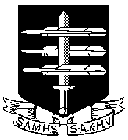 The South African
The South African
While today trucks seem to be the main mode of goods transport in South Africa, in the early years of the previous century it was the railway system. By Union in 1910, the lines across the four provinces had been brought under the control of South African Railways and Harbours (SAR&H). Integration was eased by a monthly magazine, first published in September 1906, which covered the Cape Government Railways (CGR) and Central South African Railways (CSAR) for the Orange Free State and Transvaal. Natal had its own magazine from 1905 to 1907 when it joined The South African Railway Magazine. The result is a treasure trove for historians and railway enthusiasts. However, access to this valuable resource has only been possible due to the foresight and dedication of Johannes Haarhoff to digitise it (https://documents drisa.co.za). I am additionally grateful to Sandy Buchanan (1939-2023) for drawing my attention to the collection and for introducing me to Johannes.
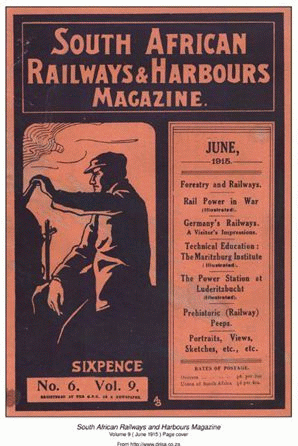
The magazine was well thought through, containing something for everyone: readers are introduced to the history of places the railways pass through, engineering and technical aspects of trains and lines, how they compare internationally, new developments around the world, as well as local movements of staff, events, gardening advice, a children's section, Letters to the Editor, and is well illustrated. The publication provided an opportunity for management and the Railway Minister to share information and policy with staff. What follows are some highlights from this rich collection covering 1914 and 1915. One quirky statistic noted the ocean level at Panama Canal varied by 13 to 19 feet, while at Port Said and Suez it was of a 'trifling nature'. (February 1915).
The outbreak of war and the economy
Not surprising, the August 1914 magazine had no- mention of war breaking out: the cataclysmic event erupted after the journal's publication. In September 1914, the editorial noted South Africa was 'prepared to do its share' and that calling out the 'Active Citizen's Force has been met with a ready and cheerful response.' Reassurance was given that it would be business as usual. Government would try to keep prices low, prevent unemployment and relieve distress. Already in September 1914 staff were encouraged to plant 'vegetables on any unused cultivable land belonging to the Administration.' As an incentive, surplus stock could be sold legally. A year later, it was reported that the rebellion and war had affected the transport of maize when for three months there had been no movement of the grain.
Almost immediately, train schedules changed as traffic reduced. Some services were cancelled. In February 1915 Major- General Thompson, GOC, SA Military Command, thanked railway workers for supporting the military. '... Particularly during the first two months of mobilisation, when it was often found necessary to order trains at very short notice, and sometimes to cancel or alter them at the last moment, [...] the smooth working of the system and the energy and willingness of the SAR officials and employees most noticeable ...'
Shipping was also affected. The Llanstephan Castle which left Durban on 27 July 1914 for Mombasa was forced to turn back from Zanzibar. Back in Durban, on 13 August passengers were still waiting to hear about their revised travel arrangements. In April 1915, of the 41 Union Castle Line steamers, 21 were in use by the British authorities, resulting in import and food shortages and reduced exports.
After six months of war, it was predicted that 'A full year of war would cost Britain £450,000,000, a sum 10 per cent more than the Rand has hammered out in 27 years of its existence'. This was over twice the value of British merchant shipping estimated at £164,500,000, but much less than any of the Great Powers in the war. Germany and Russia were spending £3,000,000 per day, while France and Austria were spending £2,000,000 per day (February 1915).
The July 1915 magazine saw a change in colour and quality of the paper used for thecover. 'Paper manufacturers and merchants are considerably hampered [...] and it has been found impossible to ensure a regular supply of the paper familiar to our readers for many years past. An early shipment is hoped for, and meanwhile the paper substituted is the best obtainable in this country.'
Defence Rifle Associations
A recurring theme of the war years was that of Defence Rifle Associations. September 1914 records that 'instead of doing target practice at a new range, the members of the DRA have been in a position to render practical assistance to the government', guarding bridges. Rifle Associations were regularly started during the war, the first war-time one being Johannesburg in September 1914, followed by Salt River, Bloemfontein, and Kroonstad. These, together with the Engineering Corps, were formed along military lines yet the organisations were not part of the Union Defence Force.
Despite a lack of rifles and ammunition for training, the Railway Associations had their share of action, including deaths. In 1915, the Rifle Associations began holding mock battles, such as one at Canada Junction, Johannesburg, on 6 February. This was to prepare for eventual call-up.
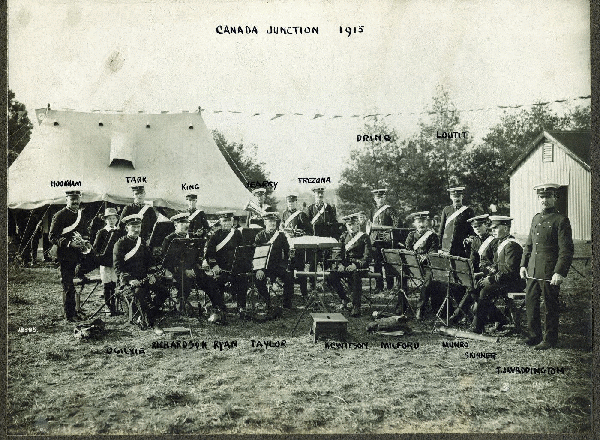
SAR&H band practice at Canada Junction, in 1915.
Back row fltr: Hookham, unidentified drummer boy, Tarr, King,
Jearey, Trezona, Drino, Loutic;
Front row fltr: Ogilvie, Richardson, Ryan, Taylor, Hewitson,
Milford, Munro, T.J. Waddington.
However, by May 1915, there was a noticeable reduction in the membership, attributed to the lack of rifles and the cost of ammunition. On 10 December 1914 at Berea Park, the 300 assembled Pretoria Railway Commando men were informed by Smuts that 'the Government had to arm a far larger body of men than at first had been anticipated. There were in the field at the present time, not including those who were in training, more than fifty thousand men.'
Engineering Corps (SAEC)
An Engineering Corps, based at Fort Knokke near Cape Town, was constituted with 'many hundred members' which provided a variety of specialist services throughout 1914 and 1915. In October 1914, staff at Woostock/Salt River constructed an anti-aircraft gun.
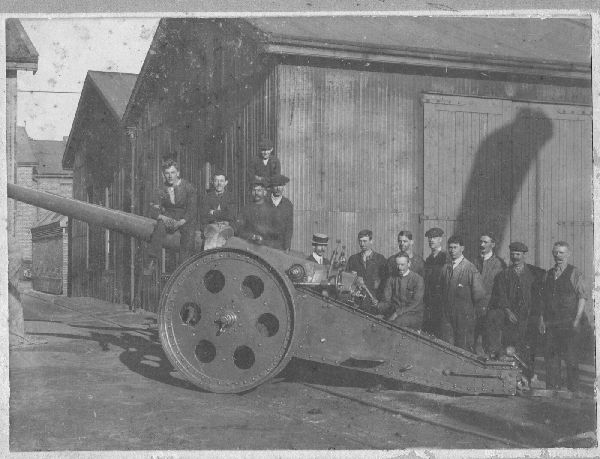
Cape Town, 1914. Manufacture of gun at Salt River
workshops.
SAR Mag Dec 194 p1234
In May 1915 the focus was on spotlight vehicles requisitioned by the Defence Department and supplied by the Railway Department - Helios (sun god) was commanded by Lieutenant Butchart (Railway Electrical Department) and Selene (moon goddess) by Lieutenant Rice-Waite of Johannesburg. July 1915 reported construction of a reservoir at Lüderitzbucht under the watchful eye of Corporal Laburn and Sapper Patterson. It was built in a record time of 5.5 weeks, everything being carried to the top of Diamond Hill by sack. The wall contained 140 cubic yards of concrete.
Back in 1914, things were rather disorganised. Sixty picked Free State men, 'Barrett's Boys' after Assistant General Manager Barrett, were diverted to Booysens. On arrival at Johannesburg, the men went straight into camp. Men could obtain leave and travel free on tram cars in batches of 100. There was free admission to bioscope and municipal baths. On 16 October, a smoking concert at the Railway Institute bid farewell to the contingent, although martial law required proceedings to end at 11 p.m. When Commanding Officer Dickson, who had not travelled with the contingent, arrived at Booysens on 19 October, the men were made ready for immediate transport. Their kit was placed on motor trolleys while the men marched to Kazerne before being transported to Cape Town where they spent a day. They returned to Booysens via Bloemfontein and Kimberley while Dickson and Adjutant Lesar remained in Cape Town.
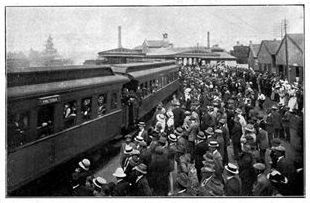
Railway contingent leaving Bloemfontein
Photo W Fray
SAR Mag Dec 1914 p1021
Comforts and fundraising
Early on, a Railway Fund was organised to assist Belgian refugees. In time, this formed part of the Governor General's Fund to which employees pledged part of their wages. These were allocated to specific causes, according to the employee's desire. In September 1915, '... among the contributions received was one of £1 for the Prince of Wales Fund, from 'Native Kleinboy, employed on Construction at Motkop.' Monthly reports gave totals donated to each fund according to region as well as notice of specific fundraising events. People were generous - by the end of 1914, Bloemfontein alone had raised £200.
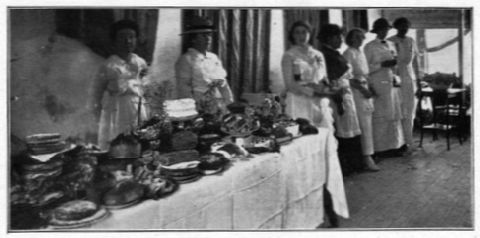
Braamfontein Ladies' committee at their
tea cake and candy sale in Eloff Street
which raised £90 on 1st October 1914
SAR Dec 1914 p 1019
Comfort Committees run by the wives and female employees did needlework of various kinds, putting packs together for those serving as well as supplying stocks for railway ambulances and hospitals. By January 1915, the Ladies' Working Committees had sent 440 bags of comforts to the front. Each contained a khaki shirt, cholera belt, pair of socks, house-wife [hussif], towel, cake of soap, tin of boracic powder, tin of Keating's powder, packet of cigarettes and matches, pack of post-cards and pencil. Another 516 bundles were sent containing a handkerchief, house-wife, socks and other useful odds and ends, while 275 wounded badges, numbers of pyjamas, night-shirts, sheets, and other comforts for the sick were provided. The Durban Committee, only begun in March 1915, reported in September that '44 parcels were still to be completed and would be sent to Lady French for distribution amongst the troops in Flanders.'
According to the August 1915 magazine the Bloemfontein Women had 'produced over 25 weeks, [.] 219 shirts, 195 pairs socks, 1480 handkerchiefs, 320 veils, 97 balaclava caps, 88 Havelock curtains, 121 pairs underpants, 23 knitted and crotched(sic) scarfs, 16 sleeping caps, 48 housewives, 111 armbands, 25 cholera belts, 160 sulphur bags, 114 camphor bags, 46 ration bags - all handmade.'
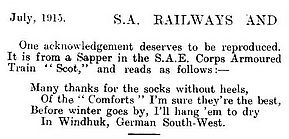
SAR Magazine
Ambulance and Armoured trains
7th Mounted Field Ambulance Brigade, managed by Dr Usmar (Railway Medical Officer, Bloemfontein-Kimberley Line), was fitted with pillows, pillowcases, old linen etc. by Lady Fraser and local ladies. The medical men went to Wynberg from where Private Radley noted they had to scrub floors and do other menial duties which was rather a change from pen pushing. Private Duke with five others went to Prieska which was 'nothing but dust, dust and dust,'
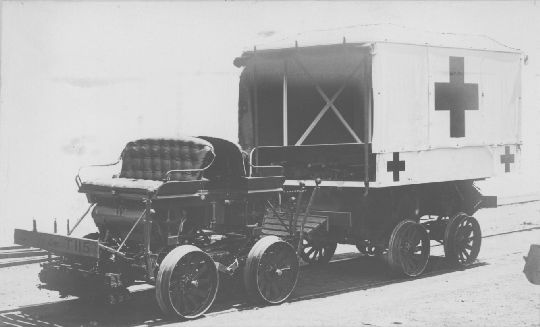
Motorised trolley with rail ambulance
in world War I
SAR Magazine
No. 6 (Free State) Hospital Train operated from Tempe, under Dr Brown, transporting wounded from Zand River, Virginia and Winburg. No. 1 (Transvaal), used in 1899 -1902 as part of Princess Christine's Ambulance Train, was also in operation. The trains accommodated 24 lying down patients, 40 sick with seats and 12 in the van. There were two wards (ordinary first-class coaches with slung beds), kitchen, van, dining room, and cosy bedroom for the nurses. Essentially it was 'a compact hospital on wheels.' Surgeon Captain Joubert, two women nurses, Sergeant Chadwick, two orderlies and a chef were on board ensuring the train was always ready, as was the engine. When needed, the doctor and nurses living at the National Hospital were phoned for.
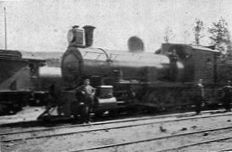
An Armoured 8th Class Engine
Photo: T. Black
SAR Magazine Dec 1914 page 1032
There were also Armoured Trains. No. 3 Armoured Train, Erin, engaged with De Wet's rebel force on 16 November at Rietspruit where rebel sharp-shooters fired from behind a wall, wounding Sapper Pindar, before the bullet deflected killing Sapper H.G. Marais. Erin was not sent to GSWA. No. 5 Armoured Train, Schrijkmaker, commanded by Captain E.R. Adams made its maiden voyage from Booysens to Pretoria. On Saturday 19 December 1914, Skrijkmaker visited Port Elizabeth causing much excitement, before leaving for GSWA on 23 January. By the end of January, No. 1 Armoured Train, Trafalgar, commanded by Captain Clough, was at Lüderitz with the staff complaining that armoured train work in GSWA was not as interesting as in the Union.
The situation was expanded on: '... The Rand Light Infantry [...] are camped in [...] the worst desert I have ever seen, even in Bechuanaland. All the water is "carted" from [Lüderitz], and it has to be condensed sea water. [...] There is no water between the sea coast and Garub (64 miles), and which we have not yet taken, as they have to distil all the water at the condensing plant at Lüderitz - that is, all which is not brought from Capetown by steamer [...] At present, we are eating our hearts out with desire to fight, and are getting tired of waiting. Some are busy putting the armoured train together, and some are acting as station foremen on the line, whilst others are helping the Engineer Corps in the workshops. We are living in German houses - very comfortable quarters, with electric light and water laid on - and plenty of German books which we cannot read. Most [...] have a diamond or two each, but they are miserable little things, worth about ten "bob" and not worth the fag of going to look for. (March 1915).
Military service
The Labour Legion in Cape Town was recruiting for the 2nd Battalion East Lancashire Regiment, part of the Imperial Garrison, which had been in Wynberg from 1911. This was to fill the ranks before the unit returned to Europe in October and then to the Western Front (wartimememoriesproject. com).
In October 1914, South Africa suffered one of its worst railway accidents when a train carrying the Kaffrarian Rifles derailed at Hex River on the 10th with the loss of eight killed and 77 injured. Most were from East London and King William's Town. After a period of recovery, the Kaffrarian Rifles served in GSWA, although by all accounts did not see action.
Ganger Hansen struck an early blow at the rebels when on 29 October, he captured rebel commandant Esterhuizen who had three days previously commandeered the whole staff at Treurfontein Station. Esterhuizen gave no resistance on being apprehended, and at Ventersdorp was handed over to Commandant Enslin for removal to Johannesburg. In ignorance of Esterhuizen's fate, rebel leader Claasens set out for Treurfontein where he was defeated by Colonel Alberts. The same week, two escaped German prisoners of war mistook a funeral party for De Wet's Commando which they were looking for and were recaptured and retrained 20 miles away.
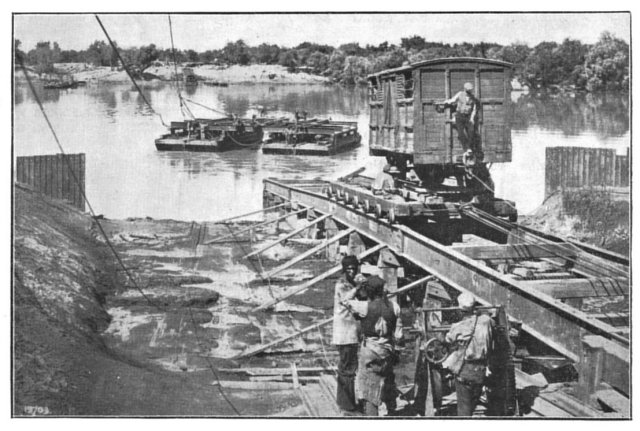
Last day of the pont
SAR Magazine June 1915 p530
Railway achievements were elaborated: Of 75 days, eight days of plate-laying and linking to sidings were partially lost owing to military traffic between Prieska and Upington. It was recorded that notification was received from the military on 14 August 1914 to start the line. The survey began on 24 August, earthworks on 31 August and the line was completed on 25 June 1915, while the first train crossed the Orange River on 16 April. There being no time to place 'orders for materials overseas', they ransacked the Union for 'rails, sleepers, bolts, points, fishplates, etc.' to construct 314 miles of railway. "All material and food supplies had to be hauled at times over four hundred miles. [... moving] troops, transportand military stores often required the exclusive use of the line' putting 'severe strain' on engineers. On average they built one-and-a-half miles a day, once five miles, working day and night in three shifts. Simultaneously, material was supplied for the line from Walvis to Swakopmund (24 miles) and destroyed lines repaired. In all, an average of 2,000 white and 5,000 black men were employed on the construction of the line (August 1915).
The Catering Department constructed a base supply depot at Prieska, sending a travelling store out about twice a week. 'At the railhead another store on wheels was stationed, which periodically travelled to and catered for the linking-up parties as they moved on. Where the plate-laying ended, provisions were 'carried on by means of road, mule and donkey wagons going out to the camps of the blasting parties.. The ruling gradient was 1 in 66 and trains would travel at fifteen miles per hour (August 1915).
On 19 October, the first allied train in GSWA ran from Lüderitzbucht to Kolmannskoppe. The line had been adapted toSouth African gauge and rolling stock brought in from the Union, landed and fixed by T.S. Parkyns, Jimmie Orr and Arthur W. Redick (a rugby player and fastbowler). The 16km trip took 68 minutes compared with the German passenger trains of 45-60 minutes.
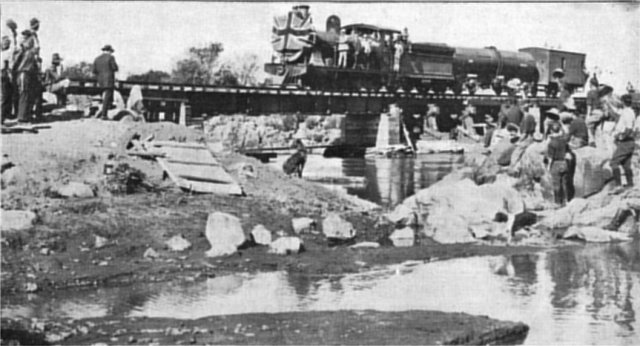
Testing and Opening the Temporary
Bridge over the Orange River
SAR Magazine June 1915 p530
Kimberley was extremely busy, as reported in December 1914: 'troops, guns, horses and munitions of war generally are daily, almost hourly, to be seen, reminding one of the stirring times fourteen years ago. [...] De Beers having ceased mining operations, practically every able-bodied man on the diamond fields belongs to some branch or other of the Defence Force .. There was a large base camp at Beaconsfield which regularly housed 2-3,000 men and horses. The Northern Districts' Agricultural Show Grounds and buildings, and Race Course grounds were occupied. A special tram service ran between Kimberley and the camp with final trams between 11 p.m. and midnight.
On 1 January 1915, there was little military action for the Pretoria, Transvaal Scottish, Rand Light Infantry, Red Cross, Medical Staff Corps and Kimberley Regiments at Tsichaukaib: 'New Year's day dawned fine and clear, and, thanks to our aeroplane "friend", "Jim Fish", celebrating his New Year with his friends, we were able to start the sports punctually at 7 a.m.' The day 'did much to relieve the monotony of an arduous campaign, and [...] was much enjoyed by officers and men alike ...' (March 1915).
Nearly 4 months later, on 22 March 1915, Cpl. E. H. Hood, 2nd Battalion Transvaal Scottish, E (Railway) Company, wrote: 'disappointed that[...] we had had very little scrapping, as the Germans, as soon as they see us, do a rearguard action in about half the time it takes an SAR express to run between Johannesburg and Publicofontein [sic]. [...] hard work has not been forgotten, and all of us from top to bottom would now pass an examination to qualify us for certificated navvies. We are quite past masters in the art of making trenches, building block-houses, off-loading ships, pushing railway trucks, ploughing for dynamite, cleaning out poisoned wells, and a host of other light(?) jobs. Every night for a fortnight in the trenches is also amongst the pleasure trips we get here, and these are augmented during the day by filling sandbags (200lbs) and throwing them about.. (May 1915)
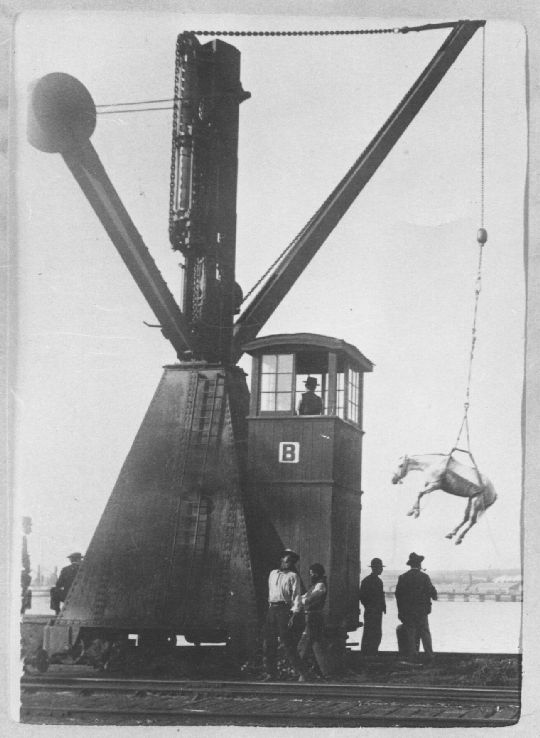
Loading horses at Port Elizabeth Harbour.
SAR Magazine
Hood also described the landing at Swakopmund. The Transvaal Scottish being the first regiment to enter Walfisch Bay, divided the honour with the Rhodesia Regiment for entering Swakopmund on 16 January 1915. They had been assisted by the Durban tug St John, HMS Astrea and the armoured tug Afrikander (May 1915).
From the Railway Budget(April 1915) we learn that nearly 4,000 railway workers were on active service; more than 12 per cent of the white staff. The SA Engineer Corps, 650 men, was composed 'almost entirely' of Railway officials. 'All sorts of contrivances had to be resorted to in connection with the landing work; piers had to be built and much other work done to facilitate the discharge of vessels.... In one ten-mile section, the line had been damaged in about 900 places. Other activities could not be reported for security reasons. SAR was busier than usual moving troops, animals and supplies, while having to deal with serious washaways in the Northern Provinces and drought difficulties in the Cape. Those left 'behind have fitted up guns, pontoons, armoured trains and motors, ambulance trains and cars, transport motors, searchlights, and X-Ray appliances.. Most of the work was done at Salt River, but some also in Pretoria. Staff 'assisted in the purchase of provisions, equipment and other supplies for military purposes, and in the chartering, fitting up, arranging and loading of transports; [...] manned the tugs and harbour plant in use in [GSWA]' (April 1915).
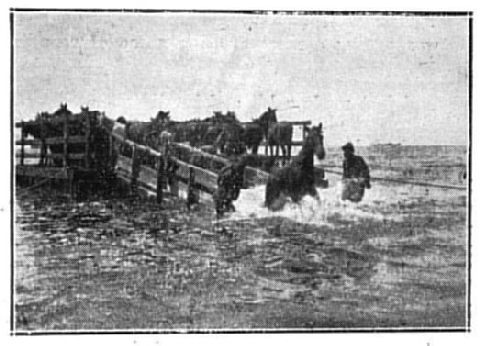
Landing horses and mules
at Walvis Bay.
The Cartage Department at Kazerne was used by the Defence Department as a recruiting office and transport depot, and later as a Remount Depot for the Rand Regiment and others. Some 40 members, clerical and artisan, were loaned to government. During the rebellion, the depot dealt with 'over 2000 mules, over 2000 horses, and nearly 1000 donkeys, and about 300 vehicles and equipment of all descriptions [... in] very limited space [...] All the animals [...] brought to the stables required branding and numbering, and they had to be shod, fed and properly cared for ...' (July 1915). Elsewhere (June 1915), how the horses were loaded onto ships was explained in detail.
Throughout, tributes were paid to colleagues lost in Europe and Southern Africa. Captain Herschell of E Company, 2nd Transvaal Scottish was wounded in the shoulder but insisted on leading a counter -attack rather than go to hospital. This engagement was 'hot! I can assure you I've never seen anything like it before, and all the chaps here who were through the Boer War state nothing was seen like it in their time, unless it was Magersfontein.'
Achievements, promotions, and other snippets were recorded. A German flag captured at Lüderitzbucht was presented to the SAR Board Room when Sergeant Duncan Munro brought it back with him on sick leave (May 1915).
Return from GSWA
The campaign in GSWA ended on 9 July 1915 with South Africa the victor. However, from as early as April, troops no longer needed in the field were returned to the Union, with the result that there was no opportunity to give them a proper welcome. General Manager William Hoy therefore suggested a special outing on 11 September at Canada Junction while other local receptions were arranged. In the meantime, the men returned to duty and were said to be 'looking well and fit after their arduous campaign', although they complained that 'there was not sufficient actual fighting' in GSWA (September 1915). They did not have long to wait as September 1915 marked the start of a new phase in South Africa's involvement in the war. With numerous men joining the Overseas Expeditionary Force, the September 1915 editorial lamented that 'South Africa can do more to support the Mother Country'. How the Union went on to serve in Europe, East Africa, the Middle East and Russia will feature in future articles.
About the Author
Dr Anne Samson is a World War I specialist. She runs the Great War in Africa Association and has published widely on the campaigns in East, Central and Southern Africa.
Her latest major project is South Africain WWI: www://southafricaww1.com
Return to Journal Index OR Society's Home page
South African Military History Society / scribe@samilitaryhistory.org